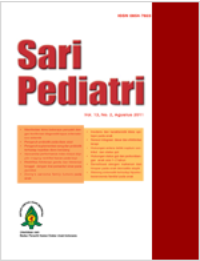Hubungan antara Malondialdehyde (MDA) dengan Hasil Luaran Sepsis Neonatorum
Sari
Latar belakang. Sepsis merupakan penyebab morbiditas dan mortalitas terbanyak pada neonatus. Pada sepsis terjadi peningkatan stres oksidatif yang menyebabkan kerusakan jaringan dan hemolisis. Kadar MDA serum merupakan biomarker adanya stress oksidatif.
Tujuan. Mengetahui hubungan antara MDA serum dengan hasil luaran sepsis pada neonatus.
Metode. Penelitian observasional prospektif dilakukan pada neonatus sepsis yang dirawat di PBRT (Peawatan Bangsal Risiko Tinggi) RSUP Dr. Kariadi Semarang, Oktober 2007 sampai dengan Januari 2008. Diagnosis sepsis berdasar gejala klinik dan pemeriksaan laboratorium. Keluaran sepsis dikelompokkan menjadi dua yaitu perburukan (BR) dan perbaikan (BI). Kadar MDA serum diukur dua kali saat terdiagnosis sepsis (MDA1) dan pada hari ke-5 atau bila terjadi disfungsi organ / meninggal / perburukan (MDA2) dengan menggunakan metode spektofotometri. Analisis statistik menggunakan Uji Wilcoxon Signed – Rank, Mann-Whitney, ROC analysis dan Fisher-exact.
Hasil. Subjek penelitian terdiri dari 41 neonatus sepsis, 33 neonatus BI dan 8 neonatus BR. Rerata kadar MDA1 2,97±0,14 dan MDA2 3,05±0,34. Kadar MDA 1 kelompok BI 2,95±0,117, kelompok BR 3,08±0,172 (p=0,03). Kadar MDA2 kelompok BI 2,97±0,182, kelompok BR 3,38±0,591 (p=0,006). Kelompok BI MDA2 meningkat tak bermakna (p=0,9), kelompok BR, MDA2 meningkat bermakna (p=0,01). Kurva ROC luas area bawah kurva MDA1 0,75 (p=0,03), cut-off-point= 2,928 ng/mL. Dijumpai hubungan bermakna antara kategori MDA1 dengan luaran sepsis (p=0,02). Risiko relatif MDA1 ≥2,928 ng/mL untuk hasil luaran sepsis perburukan 7,4 X (95% CI=1,4-37,2).
Kesimpulan. Terdapat hubungan antara kadar MDA serum dengan hasil luaran sepsis neonatorum. (
Kata Kunci
Teks Lengkap:
PDFReferensi
Jain N, Jain VB. Neonatal sepsis. Dalam: The neonate. a practical manual of common newborn problems. New Delhi: Aditya Med Publ; 2003.h.80-4.
Stoll BJ. Infections of neonatal infant. Dalam: Behrman RF, Kleigman RM, Jenson HB. penyunting. Nelson Textbook of Pediatrics. Edisi ke-17 Philadelphia: WB Saunders Co; 2004.h.623-40.
Short MA. Linking the sepsis triad of inflammation, coagulation, and suppressed fibrinolysis to infants. Adv Neonatal Care 2004; 5: 258-73.
Shulman ST. Pengenalan penyakit infeksi. Dalam: Dasar klinis dan biologis penyakit infeksi edisi IV (terjemahan). Gajah Mada University Press; 1994.h.1-5.
Latief A. Pendekatan diagnosis sepsis. Dalam: Prosiding Simposium Nasional PGD VI: Pendekatan mutakhir tata laksana sepsis pediatrik; Medan: 2003. h.28-35.
Gerdes JS. Diagnosis and management of bacterial infections in the neonate. Pediatr Clin North Amer 2004;51: 939-59.
Departemen Kesehatan & Kesejahteraan Sosial RI. Sensus Kesehatan Rumah Tangga (SKRT). 2002.
Anonymous. Protap Pelayanan Perinatologi RSDK. Unpublished.
Rohsiswatmo R. Kontroversi diagnosis sepsis neonatorum. Dalam: Update in neonatal infection. Pendidikan Kedokteran Berkelanjutan IKA XLVIII. Jakarta; 2005.h.32-4.
Paterson, RL, Webster NR. Sepsis and inflammatory response syndrome. J Royal Coll Surg Edinburgh 2002; 45:178-82.
Marshall, John C, Taneja R. Terminology and conceptual challenges, Dalam: Sepsis and multiple organ dysfunction. a multidisciplinary approach. Philadelphia:WB Saunders Company; 2000.h.12-8.
Langseth L. Oxidants and antioxidants: some basic concepts. Dalam: Bracco U, Jardine NJ, penyunting. Oxidants, antioxidants, and disease prevention. Belgium: International Life Science Institute; 1994.h.1-4.
Oski FA, Naiman JL. Disorder of red cell metabolism. Dalam: Hematologic problems in the Newborn. Edisi-2. Philadelphia: WB Saunders Co; 1972.h. 83-132.
Droge W. Free radicals in the physiology control of cell function. Physiol Rev 2003; 82: 47-95.
Yigit S, Yurdakok M, Kilinc K, Oran O, Erdem G, Tekinalp G. Serum malondialdehyde concentration as a measure of oxygen free radical damage in preterm infants. J Turk J Pediatr 1998;40:177-83.
Pepe MS. The statistical evaluation of medical tests for classification and prediction. New York: Oxford University Press; 2003.h.225-7.
Monintja HE. Infeksi sistemik pada neonatus. Dalam: Yu VYH, Monintja HE, penyunting. Beberapa masalah perawatan intensif neonatus. Jakarta: Balai Penerbit FKUI; 1997.h.545-9.
Sales-santos M, Bunye MO. The complete blood count and hematologic finding as screening criteria for neonatal sepsis. Proceedings of Makati Medical Center;199:40-50.
Yagi K. Assay for blood plasma or serum. Methods Enzymol 1984;105:328-31.
Halliwell B. Reactive oxygen species in living systems: source, biochemistry and role in human disease. Am J Med 1991; 91 (suppl 30) : 14S-21S.
De Zwart LL, Meerman JHN, Commandeur JNM, Vermulen NPE. Biomarker of free radical damage. Application in experimental animals and humans. Free Rad Biol Med 1998; 26: 202-26.
Kapoor K, Basu S, Das BK, Bhatia BD. Lipid peroxidation and antioxidants in neonatal septicemia. J Trop Ped 2006 52:372-5.
Batra S, Kumar R, Seema, Kapoor AK, Ray G. Alterations in antioxidant status during neonatal sepsis. Ann Trop Paed 2000; 20: 27-33.
Benjamini E, Coico R, Sunshine G. Hipersentivity reaction:Antibody-mediated (Type II) Cytotxic reactions and Immun complex (Type III) reactions. Dalam: Benjamini E, Coico R, Sunshine G, penyunting. Immunology, a short course. Edisi ke-4. New York: Aj Wiley and Sons; 2000.h.301-11.
Nielsen F, Mikkelsen BB, Nielsen JB, Andersen HR, Grandjean P. Plasma malondialdehyde as biomarker oxidative stress reference interval and effects of life style factors. Clin Chem 1997; 43:1209-14.
Dalle-Donne I, Rossi R, Colombo R,Giustarini D, Milzani A. Biomarkers of oxidative damage in human disease. Clin Chem 2006;52:601–23.
DOI: http://dx.doi.org/10.14238/sp12.2.2010.82-7
Refbacks
- Saat ini tidak ada refbacks.
##submission.copyrightStatement##
##submission.license.cc.by-nc-sa4.footer##
Email: editorial [at] saripediatri.org


Sari Pediatri diterbitkan oleh Badan Penerbit Ikatan Dokter Anak Indonesia
Ciptaan disebarluaskan di bawah Lisensi Creative Commons Atribusi-NonKomersial-BerbagiSerupa 4.0 Internasional.




